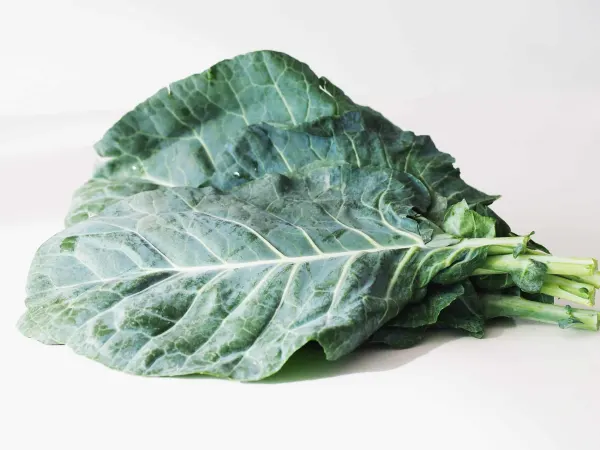Acceda a la base de datos First Foods® en Solid Starts App.
Leer másCol berza
Vegetal
Sugerencia de edades
6 meses
Alto contenido de hierro
No
Alérgeno común
No

When can babies have collard greens?
¡Lo sentimos, esta página aún no está disponible en español! Estamos trabajando tan rápido como podemos para traducir todo nuestro contenido, gracias por tu paciencia y apoyo.
Collard greens may be introduced as soon as baby is ready to start solids, which is generally around 6 months of age.
How do you serve collard greens to babies?
Cada bebé se desarrolla a su propio ritmo, y las sugerencias que ofrecemos sobre cómo cortar o preparar determinados alimentos son generalizaciones para una amplia audiencia.
6 months old +:
Offer finely chopped or shredded cooked collard greens mixed into mashed potato, porridge, polenta, or another soft food that baby can scoop. While you can offer the soft, well-cooked pieces of collard on their own, the small pieces may cling to baby’s tongue and the inside of their mouth. Mixing the small pieces into soft, scoopable foods or mixing them into finger foods like egg strips or meat patties can minimize gagging and make the food easier to eat.
9 months old +:
Offer shredded cooked or raw collard greens and encourage baby to pick up the thin strands with their fingers. Worried about raw greens? Try not to be. While a bit more challenging to chew and move around the mouth, the texture is terrific for building baby’s eating skills. Spitting out food is totally normal. Alternatively, continue to serve finely chopped, cooked collards mixed into other foods.
12 months old +:
Serve collard greens as desired, cooked or raw, chopped, shredded, or in larger pieces. Continue to expect some spitting, but you may start to see more swallowing and consumption around this age, especially as the molars come in, which help the child grind more challenging textures. This is also a great age to encourage self-feeding with utensils. If the child needs help, simply preload an age-appropriate utensil and lay it next to the food for the toddler to pick up.
Videos
Are collard greens a choking hazard for babies?
No. Collard greens presents a low risk when safely prepared for a child’s age and developmental ability, though, in theory, an individual could choke on any food. To reduce the risk, prepare and serve collard greens in a developmentally-appropriate way as described in the How to Serve section. Greens can also cause some gagging or coughing as the leaves cling to baby’s tongue or the roof of their mouth. Offer a drink in an open cup to help baby wash any pieces of food down. As always, create a safe eating environment and stay within reach of baby during meals.
Learn the signs of choking and more about choking first aid in our free guides, Infant Rescue and Toddler Rescue.
Are collard greens a common allergen?
No. Collard greens are not a common allergen, however, allergies to other vegetables in the cruciferous vegetable family have been reported. Those with allergies to other cruciferous vegetables may experience a similar reaction when eating collards. Individuals with Oral Allergy Syndrome (also called pollen fruit syndrome), and in particular, those with sensitivities to mugwort pollen, may also be sensitive to cruciferous vegetables. Oral Allergy Syndrome typically results in short-lived itching in the mouth and is unlikely to result in a dangerous reaction.
Are collard greens healthy for babies?
Yes. Collard greens are rich in fiber and fluid, in addition to micronutrients like calcium, folate, magnesium, potassium, and vitamins A, B6, C, E, and K. They also contain plant compounds called glucosinolates that may have anti-cancer properties. Together, these nutrients support baby’s developing gut microbiome, bone density, brain development, vision, metabolic processes, iron absorption, blood clotting, and more.
Do I need to worry about the nitrates in collard greens?
No. Offer vegetables that contain nitrates (arugula, beets, carrots, lettuce, spinach, and squash, to name a few) as part of a variety of foods in the diet. Nitrates are naturally-occurring compounds which, if consumed in excess, may negatively affect oxygen levels in the blood. That said, babies who are allowed to self-feed typically do not consume excessive amounts of solid food because they need lots of practice to learn how to eat it and can follow their hunger and fullness cues. Nitrates in vegetables are generally not a cause for concern, and the benefits of introducing these vegetables as part of a balanced diet typically outweigh the unlikely risk of excessive consumption.
Nuestro equipo
Escrito por
Consejos de expertos directo a tu bandeja de entrada
¡Suscríbete y recibe correos semanales con recetas, consejos y más!
Copyright © 2025 • Solid Starts Inc






